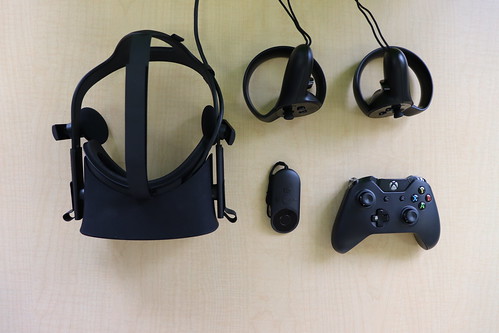Assignment #4: Virtual Reality
What is VR?
Virtual Reality is a computer environment that represents, in a digital way, something that pretends to be real. It is generated by a person using special electronic equipment, such as a helmet with a screen inside or gloves fitted with sensors.
(Photo:Virtual Reality at the Library By:San José Public Library License CC)
Technology
Technology is the application of a set of knowledge and skills through electronics with the objective to achieve a solution that allows the human being from solving a given problem until reaching a need in a specific area.
History
Virtual reality has been a concept that has been developed throughout the years. It actually began in the nineteenth century when the idea was presented by Charles Wheatstone in 1838, when he began the development of the popular View-Master stereoscope (patented 1939), wich was used for “virtual tourism”.
Before then, panoramic paintings were the earliest attempt at virtual reality, as they were 360 degree murals intended to make viewer feel like they were present.

(Photo: Borodino Battle Museum Panorama By:tripadvisorLater on, the concept of virtual reality was taken in 1929 when Edward Link created the “Link trainer” (patented 1931) probably the first example of a commercial flight simulator, which was entirely electromechanical. After that, the idea slowly started changing to a much simple concept, especially after the 1930s story by science fiction writer Stanley G. Weinbaum (Pygmalion’s Spectacles) was published, that presented virtual reality being seen through a pair of goggles.
In the mid 1950s cinematographer Morton Heilig then developed the Sensorama (patented 1962). Which was an arcade-style theatre cabinet that would stimulate all the senses, not just sight and sound.

(Photo:Sensorama-morton-heilig-virtual-reality-headset.jpg Created: 3 March 2016 CC BY-SA 4.0)
Since then, then the concept has been taken by several people who have slowly built this, to be a revolutionary invention in the 21 century.
Virtual reality today:
Apps
Augmented Reality
This involves literally augmenting reality with virtual information. An augmented reality app will typically annotate live video with information in various formats. One novel example is a table top racing game in which you actually race on your table.
Read more about Augmented Reality here.
Virtual Worlds
Virtual worlds, such as Second Life, are played over the internet using a Mac or PC. Such applications open up a sandbox, allowing you to manipulate the world around you and can often feature their own currencies, with exchange rates to boot. There is even a booming virtual real estate market on Second Life.
Read more about Virtual Worlds here.
Kinect
This recent release by Microsoft probably offers one of the most in-depth virtual reality experiences around. The Kinect, at its core, is a motion sensor for the Xbox 360. Combining this with an expansive virtual world and goggles, you can become as immersed as you could possibly get.
Experts on Virtual Reality
- Twitter: @RealityVirtual
- Twitter: @CanaryVirtual
- Twitter: @RTPVR
- Twitter:@Claybavor
- Twitter: @SVVRLIVE
References
Ibáñez Gallén, M. (2017). Validación de la interacción verbal con un avatar en un ambiente de realidad virtual para generar ansiedad social. http://hdl.handle.net/10234/166800
Description: Actualmente existe una alta prevalencia del trastorno de ansiedad social (TAS), es por ello que en la última década se ha validado la eficacia de los ambientes virtuales (AV) como herramienta para realizar la exposición.
Sergio, C., Cristina, P., Silvia, R., & Marcos, F. (2017). Simulación de Plataformas Robóticas de Movimiento para Aplicaciones de Realidad Virtual Mediante Filtros Digitales. Revista Iberoamericana De Automática E Informática Industrial RIAI, Vol 14, Iss 4, Pp 455-466 (2017), (4), 455. doi:10.1016/j.riai.2017.07.001
Description: El uso de plataformas robóticas de movimiento en simuladores de vehículos y aplicaciones de Realidad Virtual es relativamente habitual. Sin embargo, el ajuste de los algoritmos que controlan su funcionamiento, denominados algoritmos de washout, no es sencillo y requiere de numerosas pruebas hasta obtener una apropiada fidelidad de movimiento. Es por ello que este trabajo presenta un método para la caracterización y simulación de manipuladores robóticos mediante filtros digitales de segundo orden, sencillo de implementar y ajustar a partir de una caracterización previa.
Botella Arbona, C., Fernández Ramos, C., & Serrano Zárate, B. (2017). Efectos de la inducción emocional usando realidad virtual en la percepción de bienestar en personas vulnerables a padecer ansiedad y depresión.
http://hdl.handle.net/10234/166389
Abásolo Guerrero, M. J., Mitaritonna, A., Giacomantone, J., De Giusti, A. E., Naiouf, M., Perales Lopez, F. J., & … García Bauza, C. (2014). Realidad virtual, realidad aumentada y TVDi.http://hdl.handle.net/10915/41310
http://sedici.unlp.edu.ar/handle/10915/41310
Description: La línea de investigación y desarrollo presentada consiste en estudiar, desarrollar y evaluar aplicaciones de realidad virtual, realidad aumentada, interfaces avanzadas y Televisión Digital Interactiva (TVDi). Uno de los principales objetivos es la formación de recursos humanos y fortalecimiento de la investigación mediante el trabajo intergrupal entre diferentes instituciones nacionales y extranjeras.
Urquiza Mendoza, L. I. (2016). USO DE LA REALIDAD VIRTUAL, EN LA EDUCACION DEL FUTURO EN CENTROS EDUCATIVOS DEL ECUADOR
http://revista.utb.edu.ec/index.php/sr/article/view/115
Description:En este artículo se realiza un análisis sobre que es la realidad virtual, cómo esta funciona, los dispositivos utilizados para su uso, y por supuesto los alcances educativos.



